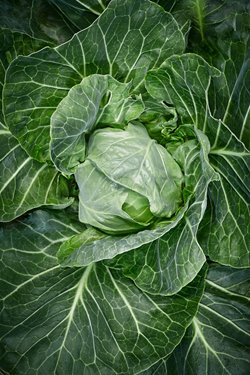
Spring cabbage is one of the more versatile varieties due to its sweet and tender flavour that goes well in many dishes. This cabbage is a member of genus Brassica, as all cabbages are, and is indigenous to both Southern and Western Europe.
It’s often referred to as spring greens due to its leafiness, and there are plenty of
great recipes to follow using freshly picked spring cabbage. There’s also a huge array of health benefits when you incorporate this cabbage into your diet, including:
- Lots of nutrients
- Keeping inflammation in check
- Helping with digestion
- Improving heart health
- Helping to lower cholesterol and blood pressure
You could soon be reaping the health benefits of these leafy greens in your own garden by following a few simple steps. Just read on to find out how easy growing your own spring cabbage is.
When to sow and plant out spring cabbage
As the name suggests, spring cabbages are harvested during spring which means you’ll need to plant them well in advance. It takes around six months to grow from the time you sow your seeds. This makes late summer or early autumn the perfect time to begin the growing process.
This gives the crop enough time to grow and harden off before winter which increases its chances of survival as temperatures begin to drop.
How to grow spring cabbage
The process is straightforward when it comes to growing spring cabbage plants in the UK. Here’s how to get started.
Step one: Sow your spring cabbage seeds
Begin by sowing your spring cabbage seeds in firm soil in modular trays in late July or early August.
Once sown, place your modular tray in a spot that gets plenty of sunlight and let it grow for several weeks.
Step two: Plant your spring cabbages in the ground
Once your sown seed has grown five leaves or more, transplant it into the ground in its final growing position.
Begin by watering your plant well the day before planting. Next, dig holes that ensure the cabbage plant’s lowest leaves are at ground level. How far apart you plant your cabbage depends on the variety, but for spring cabbages, they need to be 10cm apart in rows of 30cm.
Finally, place the spring cabbage plants in the hole, puddle in the plants with water and then fill with soil.
Step three: Maintenance
Throughout the growing phase, you need to water the plants following prolonged dry spells. A thorough soak every 10 days is recommended for this. Give them a generous amount of water once the heads come through the soil to increase the size.
How is spring cabbage harvested?
It takes roughly six months to grow but you can decide when the spring cabbage is ready to harvest when it reaches your desired size. Try not to leave it too long, however, as they may begin to run to seed.
Harvesting spring cabbage is simple too. Use a knife to cut across the stem at ground level and you’ll have your fully matured cabbage to enjoy.
To get the most out of your gardening efforts, you can replant the stump once the leaves are removed to grow another smaller one. To do this, make a 1cm deep cross in the stump and repeat the planting process.
Protect spring cabbages while they grow
Like most plants that you grow in your garden, there are several dangers that spring cabbage may face during its growing period. Here are some examples and solutions to keep your spring cabbage growing at its best.
Cabbage root fly
These white larvae sit just below the soil surface and feed on the roots of the cabbage plant. This can result in stunted growth or even the death of your crop.
Fortunately, there’s a quick fix for this. Simply cover your spring cabbage with insect-proof mesh or horticulture fleece.
Caterpillars
These pests love all cabbages, so you may find some trailing over your plants during the growing period. The easiest way to spot them is to look for holes in the leaves.
If any holes appear then you must act fast and pick the caterpillars off before they cause more damage. To prevent them from appearing in the first place, use insect-proof mesh or fine netting.
Club root
When your spring cabbage receives too much water without proper drainage, for example through rainfall, the root appears swollen and pale in colour. This can lead to plants dying. Once the soil has been affected by this, you won’t be able to use it again.
A way to avoid this issue is to add lime to the soil to increase its alkaline levels. British weather can often result in heavy rainfall, so providing cover using a polytunnel may be a wise option.
Slugs and snails
Other pests that enjoy cabbage, particularly in its young phase of growth, are slugs and snails. They feed on the seedlings and can be spotted by looking for slime trails around your spring cabbage.
You can control your slug and snail infestations by using beer traps, eggshell barriers or copper tape.
Start growing your spring cabbage with Premier Polytunnel
With a need for sunlight and shelter from heavy rainfall, you can expect your spring cabbage to thrive when grown in a polytunnel. If you’re ready to grow spring cabbage, why not do it in one of the many polytunnels we have for sale at Premier Polytunnels? We have a
range of different sizes for you to browse, so we’re confident there’ll be one to fit your outdoor space.
To find out more about our polytunnels,
call us or email
info@premierpolytunnels.co.uk with any questions you may have. Our team will be on hand to support your queries.
Be sure to check out our
blog too and discover tips and tricks for growing your favourite crops in your garden.